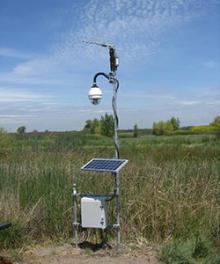Students with a variety of skills and perspectives make up a team that’s taking engineering principles into some of the area’s wildlands to further education and promote awareness about the environment.
 Candace Sigmond, education coordinator for the Grasslands Environmental Center and Los Banos Wildlife Area Complex, came to UC Merced with a seemingly simple problem: She wanted to find a way to teach area schoolchildren about the wildlife area even if they couldn’t visit the site themselves.
Candace Sigmond, education coordinator for the Grasslands Environmental Center and Los Banos Wildlife Area Complex, came to UC Merced with a seemingly simple problem: She wanted to find a way to teach area schoolchildren about the wildlife area even if they couldn’t visit the site themselves.
Students enrolled in the Engineering Service Learning class, through the Foster Family Center for Engineering Service Learning, stepped up, taking UC Merced once again into the community to deliver a slice of education some children might not otherwise be able to access.
The Engineering Service Learning students came up with a solution – install a stationary, solar-powered web camera in the wetlands area and make it controllable remotely, so anyone with a computer can view the wildlife area themselves, as often as they wish, and learn about the plants and animals they see.
Though the students have a faculty mentor – in this case, Professor Tom Harmon – who provides guidance and advice, the project is primarily student driven.
“They interact with the client to determine her needs and do their best to fill those needs,” Harmon said. “And keep in mind that they are only in class two hours per week. Obviously, they need to put in more hours to overcome challenges and develop a high-quality product, so they learn a lot about professionalism.”
“It’s great – they have really done a lot,” Sigmond said. “Plus they are learning the practical application of their education, and learning about putting their ideas into action.”
This semester’s team accomplished some major goals.
“We had to find ways to make the camera self-sustaining and solve issues that prevented us from streaming the live video,” said hardware team leader Ruldip Jammu, a senior from Modesto. “We had elevation issues – we had to be able to get the camera high enough so that there was nothing blocking the antenna signals. We also had to solve power issues, which included removing a power inverter and replacing it with something more energy efficient, so the camera could last longer.”
Plus, software team leader Kyle Schmidt had to solve access problems – the camera wasn’t working on the Internet.
“That was a major challenge,” Jammu said.
But after working in the field and in the PG&E Engineering Service Learning Laboratory on campus, the team unveiled the remotely controlled web camera at the Founders Day event in downtown Merced, giving the community a peek into what UC Merced students are working on and a wide view of the wetlands.
Ryan Seuss’s education team will add many different learning components to the website so that remote viewers can look up information about what they see, including the different plants and animals that make the wetlands their home.
Senior Anthony Schiefer, the team leader, said it’s satisfying to see the wetlands team’s success, and it will be even better when Sigmond is able to take the project out to schools across the Valley, beginning in the new year.
“Candace is really striving to help underprivileged students,” he said. “Many of them would not be able to get to the wetlands, but they can learn about them, see them, get a greater awareness of the environment, and they also get to see what we have achieved and think about what they would like to achieve when they go to college.”
The students will test the webcam learning system in actual classrooms to make sure it’s working properly, giving them plenty of opportunities to interact with the schoolchildren.
Projects like this are just some of the ways engineering is helping address issues of great concern to society – in this case by increasing educational opportunities and environmental awareness for underprivileged students.
The Los Banos Wildlife Area Complex is part of a huge complex of protected lands in the Central Valley critical to dozens of species. This project could be used to educate people everywhere about this area and others like it, but it also has many other possible applications, from tracking bird and mammal migration to helping fish-and-wildlife agencies monitor and maintain the areas they oversee.
The Engineering Service Learning class is optional, and it’s open to all students – not just those majoring in engineering.
For Schiefer, who came to UC Merced from San Francisco, the course not only coincides with his passion for environmental engineering, it gives him practical experience in team and project management.
“This is a real-life client, a real case,” he said. “We have to figure out how to meet her needs, stay on budget, divide up the work, meet our weekly goals and prepare and organize the data for the next team.”
Schiefer and Jammu said they will take the Engineering Service Learning class again next semester. In fact, this is Jammu’s third semester on the wetlands team.
“I don’t want to stop,” Jammu said, “because I want to make sure it works.”



